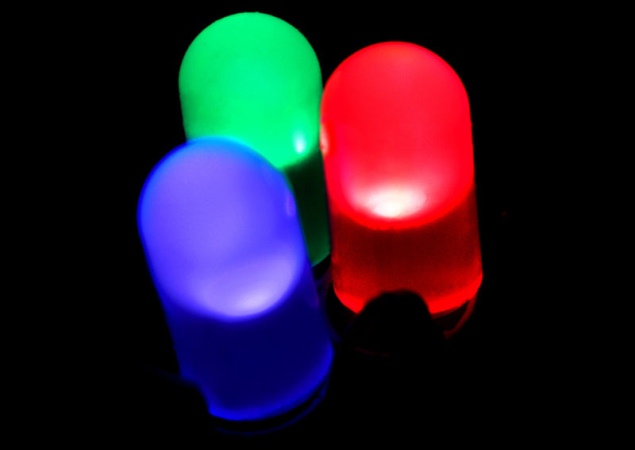- Home
- Others
- Others News
- China's LED firms no longer burning bright
China's LED firms no longer burning bright

About 4,000 companies in China are producing LEDs, or light emitting diodes, tempted by tax breaks, subsidies and offers of cheap land for factories. Now they are locked in intense competition that has halved prices over the past three years.
Just as over-investment and sagging exports dragged down Beijing's solar panel and wind turbine champions, China's much-hyped LED lighting sector, the largest in the world, is now facing a drastic shake-up.
"Everyone is making LEDs these days. The industry is a mess," Irving Pun, global marketing director of LED maker Civilight Shenzhen Semiconductor Lighting Co Ltd, said in an interview.
"This is a typical problem associated with China," he added. "Whenever a new industry is introduced here, a huge swarm of speculators will descend upon it and quickly turn it upside down."
Civilight's multi-story LED light factory in Shenzhen is surrounded by dozens of rival manufacturers. In 2006, when Pun and his colleagues set up the company, they were pioneers in an industry the central government was determined to promote as part of China's drive for green technology.
Beijing has set a target for LEDs to account for 30 percent of the domestic general lighting market by 2015, more than triple the current level. That would cut annual coal use by 35 million tonnes, according to official estimates.
If half of China's lights were LEDs, the electricity saved would be 2.5 times that of the annual output of China's Three Gorges Dam, the world's largest hydropower project by capacity, analysts say.
But domestic demand is weak. Despite subsidies and the promise of reduced power bills over time, Chinese households have been slow to switch to LEDs because they are still much more expensive to buy than conventional lights. Quality issues have also hurt consumer confidence.
Lights off
At least 20 percent of Chinese LED lighting firms may be forced out of business, according to industry experts and even some LED company officials.
"Many small LED lighting companies are suffering and may not see light at the end of the tunnel," said Wei Li, board secretary of Dongguan Kingsun Optoelectronic Co Ltd, a leading Chinese LED street lighting manufacturer.
"There won't be so many enterprises five to 10 years from now," she told Reuters by phone from the firm's headquarters in the city of Dongguan in southern Guangdong province, an LED manufacturing centre.
Industry consolidation may temporarily disrupt the world's LED supply chain given 60 to 70 percent of China's capacity is built for exports, analysts say. But in the long run, the shakeout should lead to a healthier Chinese LED industry and hence better quality products.
Shares of the more than two dozen Chinese LED players listed in China and Hong Kong, some of which attracted private equity investment before their listings, have tumbled as their profits evaporated. Ledman Optoelectronic Co Ltd is down 48 percent from a March peak, and Shenzhen Unilumin Group Co Ltd has lost 37 percent.
Foreign lighting titans including Philips Electronics NV, Osram - partly owned by German engineering conglomerate Siemens AG and General Electric Co should emerge as winners due to their financial clout and technical expertise, industry experts say.
Philips and Osram, which have traditionally focused on conventional lighting in China, have ramped up production of LEDs. Osram, which employs 8,000 people in China, started construction of its first-ever LED chip packaging plant in China in August, a 100,000-square-metre complex in the eastern city of Wuxi, using chips made in Germany and Malaysia.
Domestic winners may include Kingsun, Foshan Electrical and Lighting Co Ltd, NVC Lighting Holding Ltd, Elec-Tech International Co Ltd, Shenzhen Unilumin and Shenzhen Refond Optoelectronics Co Ltd, analysts say.
Environmental benefits
So far, LEDs are mainly used in street lighting, shopping malls, upscale hotels and office buildings. To accelerate a broader shift to efficient lighting, China in October started to phase out wasteful incandescent bulbs, joining other countries like the United States and Japan.
The diodes, semiconductors that convert electrical current into light, are much more efficient than the two dominant products for home and commercial lighting, compact fluorescent lamps (CFLs) and incandescent bulbs. LED lights are longer lasting and up to 10 times more efficient than incandescent bulbs.
Some industry experts predict that within 10 years, these lights will deliver more environmental and economic benefits than any other clean technology, including high-voltage power transmission, electric vehicles, smart grids or renewable power.
In North America, LED-based lights account for about 8 percent of the general lighting market, according to a 2012 report on the global LED sector from consultants McKinsey.
The use of these lights in the United States alone has saved 2.6 terawatt hours of power per year, equivalent to the electricity needed to power over 200,000 average U.S. households, according to a 2011 research report prepared by Navigant Consulting Inc for the U.S. Department of Energy.
In China, the world's top energy consumer and carbon emitter, general lighting accounts for 12 percent of annual electricity consumption. About 70 percent of China's electricity is generated from coal.
Beijing's billions
Despite the anticipated shakeout, Beijing remains committed to the industry. The Ministry of Science and Technology said last summer it planned to create a 500 billion yuan LED lighting industry by 2015.
It also plans to nurture 20 to 30 technologically competitive industry leaders involved in LED chip making, packaging or fixture manufacturing, and nominated the sector - now with an annual output value of about 200 billion yuan- to receive further government support.
It did not identify the leading firms.
Ben Lin, senior analyst at international LED consultancy LEDinside in Shenzhen, said they may include some listed companies as well as unlisted players such as Shenzhen Spark Optoelectronics S&T Co, Shenzhen Collection Enterprises Co and French-invested Zhongshan Juneng Hi-tech Optoelectronics & Lighting Co.
Chinese LED makers currently rely heavily on foreign companies for chips, which account for half of the production cost of the lights. Bringing that technology back home would help reduce costs. Lower costs and advances in technology are crucial if China is to meets its LED goals.
Reflecting a global trend, the Chinese LED lighting market will likely see a compound annual growth rate of over 40 percent through 2016, making up 46 percent of the country's overall general lighting industry, the McKinsey report said.
"I believe the LED era will come one day," said Zhu Jianqin, executive director of Hong Kong-listed TCOrient Lighting Holdings Ltd, which is mainly involved in LED road lighting manufacturing.
© Thomson Reuters 2013
Get your daily dose of tech news, reviews, and insights, in under 80 characters on Gadgets 360 Turbo. Connect with fellow tech lovers on our Forum. Follow us on X, Facebook, WhatsApp, Threads and Google News for instant updates. Catch all the action on our YouTube channel.
- Samsung Galaxy Unpacked 2025
- ChatGPT
- Redmi Note 14 Pro+
- iPhone 16
- Apple Vision Pro
- Oneplus 12
- OnePlus Nord CE 3 Lite 5G
- iPhone 13
- Xiaomi 14 Pro
- Oppo Find N3
- Tecno Spark Go (2023)
- Realme V30
- Best Phones Under 25000
- Samsung Galaxy S24 Series
- Cryptocurrency
- iQoo 12
- Samsung Galaxy S24 Ultra
- Giottus
- Samsung Galaxy Z Flip 5
- Apple 'Scary Fast'
- Housefull 5
- GoPro Hero 12 Black Review
- Invincible Season 2
- JioGlass
- HD Ready TV
- Laptop Under 50000
- Smartwatch Under 10000
- Latest Mobile Phones
- Compare Phones
- OnePlus 15R
- Realme Narzo 90x 5G
- Realme Narzo 90 5G
- Vivo S50 Pro Mini
- Vivo S50
- OPPO Reno 15c
- Redmi Note 15 5G
- Redmi Note 15 Pro 5G
- Asus ProArt P16
- MacBook Pro 14-inch (M5, 2025)
- Infinix Xpad Edge
- OnePlus Pad Go 2
- OnePlus Watch Lite
- Just Corseca Skywatch Pro
- Acerpure Nitro Z Series 100-inch QLED TV
- Samsung 43 Inch LED Ultra HD (4K) Smart TV (UA43UE81AFULXL)
- Asus ROG Ally
- Nintendo Switch Lite
- Haier 1.6 Ton 5 Star Inverter Split AC (HSU19G-MZAID5BN-INV)
- Haier 1.6 Ton 5 Star Inverter Split AC (HSU19G-MZAIM5BN-INV)












